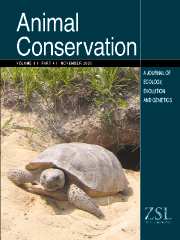Crossref Citations
This article has been cited by the following publications. This list is generated based on data provided by
Crossref.
Soulé, Michael E.
and
Terborgh, John
1999.
Conserving nature at regional and continental scales—a scientific program for North America.
BioScience,
Vol. 49,
Issue. 10,
p.
809.
Dickinson, H. C.
and
Fa, J.E.
2000.
Abundance, demographics and body condition of a translocated population of St Lucia whiptail lizards (Cnemidophorus vanzoi).
Journal of Zoology,
Vol. 251,
Issue. 2,
p.
187.
Watson, Mark
and
Thirgood, Simon
2001.
Could translocation aid hen harrier conservation in the UK?.
Animal Conservation,
Vol. 4,
Issue. 1,
p.
37.
Shafer, Craig L
2001.
Inter-reserve distance.
Biological Conservation,
Vol. 100,
Issue. 2,
p.
215.
Dickinson, Hannah C.
Fa, John E.
and
Lenton, Stuart M.
2001.
Microhabitat use by a translocated population of St Lucia whiptail lizards (Cnemidophorus vanzoi).
Animal Conservation,
Vol. 4,
Issue. 2,
p.
143.
Linklater, Wayne L.
2003.
A Novel Application of the Trivers‐Willard Model to the Problem of Genetic Rescue.
Conservation Biology,
Vol. 17,
Issue. 3,
p.
906.
Rabin, L A
2003.
Maintaining Behavioural Diversity in Captivity for Conservation: Natural Behaviour Management.
Animal Welfare,
Vol. 12,
Issue. 1,
p.
85.
Gerber, L. R.
Seabloom, E. W.
Burton, R. S.
and
Reichman, O. J.
2003.
Translocation of an imperilled woodrat population: integrating spatial and habitat patterns.
Animal Conservation,
Vol. 6,
Issue. 4,
p.
309.
WILSON, CHARLES J.
2004.
Could we live with reintroduced large carnivores in the UK?.
Mammal Review,
Vol. 34,
Issue. 3,
p.
211.
Palomares, Francisco
Revilla, Eloy
Calzada, Javier
Fernández, Nestor
and
Delibes, Miguel
2005.
Reproduction and pre-dispersal survival of Iberian lynx in a subpopulation of the Doñana National Park.
Biological Conservation,
Vol. 122,
Issue. 1,
p.
53.
Balestrieri, Alessandro
Remonti, Luigi
and
Prigioni, Claudio
2006.
Reintroduction of the Eurasian badger (Meles meles) in a protected area of northern Italy.
Italian Journal of Zoology,
Vol. 73,
Issue. 3,
p.
227.
Zeng, Yan
Jiang, Zhigang
and
Li, Chunwang
2007.
Genetic variability in relocated Père David’s deer (Elaphurus davidianus) populations—Implications to reintroduction program.
Conservation Genetics,
Vol. 8,
Issue. 5,
p.
1051.
Law, Peter R.
and
Linklater, Wayne L.
2007.
Optimising the sex ratio of translocation for genetic rescue as a function of invested resources.
Ecological Modelling,
Vol. 208,
Issue. 2-4,
p.
317.
Schwartz, Michael K.
2007.
Ancient Dna Confirms Native Rocky Mountain Fisher (Martes pennanti) Avoided Early 20th Century Extinction.
Journal of Mammalogy,
Vol. 88,
Issue. 4,
p.
921.
Stamps, Judy A.
and
Swaisgood, Ronald R.
2007.
Someplace like home: Experience, habitat selection and conservation biology.
Applied Animal Behaviour Science,
Vol. 102,
Issue. 3-4,
p.
392.
Price, Megan
2008.
Too close for comfort.
p.
163.
VONHOLDT, BRIDGETT M.
STAHLER, DANIEL R.
SMITH, DOUGLAS W.
EARL, DENT A.
POLLINGER, JOHN P.
and
WAYNE, ROBERT K.
2008.
The genealogy and genetic viability of reintroduced Yellowstone grey wolves.
Molecular Ecology,
Vol. 17,
Issue. 1,
p.
252.
Jule, Kristen R.
Leaver, Lisa A.
and
Lea, Stephen E.G.
2008.
The effects of captive experience on reintroduction survival in carnivores: A review and analysis.
Biological Conservation,
Vol. 141,
Issue. 2,
p.
355.
Gusset, Markus
Ryan, Sadie J.
Hofmeyr, Markus
Van Dyk, Gus
Davies‐Mostert, Harriet T.
Graf, Jan A.
Owen, Cailey
Szykman, Micaela
Macdonald, David W.
Monfort, Steven L.
Wildt, David E.
Maddock, Anthony H.
Mills, M. Gus L.
Slotow, Rob
and
Somers, Michael J.
2008.
Efforts going to the dogs? Evaluating attempts to re‐introduce endangered wild dogs in South Africa.
Journal of Applied Ecology,
Vol. 45,
Issue. 1,
p.
100.
Wisely, Samantha M.
Santymire, Rachel M.
Livieri, Travis M.
Mueting, Sara A.
and
Howard, JoGayle
2008.
Genotypic and phenotypic consequences of reintroduction history in the black-footed ferret (Mustela nigripes).
Conservation Genetics,
Vol. 9,
Issue. 2,
p.
389.


